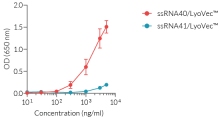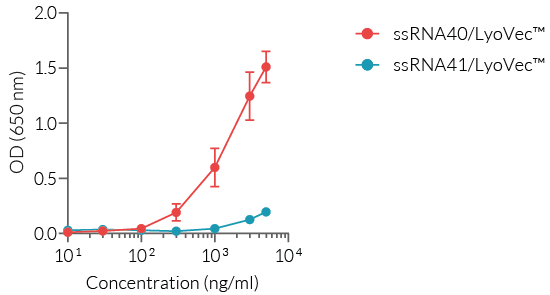ssRNA41/LyoVec™
| Product | Unit size | Cat. code | Docs. | Qty. | Price | |
|---|---|---|---|---|---|---|
|
ssRNA41 / LyoVec™ ssRNA40 control |
Show product |
4 x 25 µg |
tlrl-lrna41
|
|
Negative control for TLR8-activating ssRNA40 - complexed with LyoVec™

No activation of TLR7/8 by ssRNA41/LyoVec™
ssRNA41 is a 20-mer phosphothioate-protected single-stranded (ss)RNA oligonucleotide. It derives from the HIV-1-derived ssRNA40 by replacement of all U nucleotides with adenosine [1]. ssRNA derived from HIV-1 or the influenza virus were shown to induce the production of proinflammatory cytokines by activation of the Toll-like receptors TLR7 and/or TLR8.
Description
ssRNA41 is complexed with the cationic lipid LyoVec™ to protect it from degradation and facilitate its uptake. Moreover, phosphorothioate linkages were incorporated in order to extend the effective molecular lifetime by minimizing extra and intracellular nuclease degradation. Unlike ssRNA40, ssRNA41 is unable to induce the production of type IFNs and therefore can be used as a negative control for ssRNA40 [1,2].
InvivoGen's ssRNA41/LyoVec™ is unable to activate TLR8 or TLR7, as verified by using our HEK-Blue™ reporter cell lines expressing human or mouse TLR7 or TLR8. It serves as a negative control for ssRNA40, a potent agonist of human TLR8 (see figure).
Key features of ssRNA41/LyoVec™
- No activation of human TLR8
- Positive control ssRNA40/LyoVec™ is available
- Complexed with LyoVec™
- Each lot of ssRNA41/LyoVec™ is functionally tested
References:
1. Heil F. et al., 2004. Species-specific recognition of single-stranded RNA via toll-like receptor 7 and 8. Science. 5;303(5663):1526-9.
2. Alter G. et al., 2007. Single-Stranded RNA Derived from HIV-1 Serves as a Potent Activator of NK Cells. J Immunol. 178:7658-7666.
Specifications
Specificity: human TLR8/mouse TLR7 agonist
Working Concentration: 0.25 - 5 μg/ml
Sequence: ssRNA41 5’-G*C*C*C*G*A*C*A*G*A*A*G*A*G*A*G*A*C*A*C-3’
(“*” depicts a phosphothioate linkage)
Solubility: 0.05 mg/ml in water
Quality control:
- The biological activity of ssRNA41/LyoVec™ has been validated using cellular assays.
- The absence of bacterial contamination (e.g. lipoproteins and endotoxins) has been confirmed using HEK-Blue™ hTLR2 and HEK-Blue™ hTLR4 cells.
Contents
- 4 x 25 μg lyophilized ssRNA41/LyoVec™ 1:2 ratio (w/w)
Note: Each vial contains 25 μg of ssRNA41 complexed with 50 µg LyoVec™.
- 10 ml endotoxin-free water
![]() ssRNA41/LyoVec™ is provided lyophilized and shipped at room temperature.
ssRNA41/LyoVec™ is provided lyophilized and shipped at room temperature.
![]() Store at -20 ̊C.
Store at -20 ̊C.
![]() Lyophilized product is stable 1 year at -20 ̊C.
Lyophilized product is stable 1 year at -20 ̊C.
Upon resuspension, store product at 4°C. Resuspended product is stable 1 week at 4°C.
Back to the topDetails
ssRNA40 is a 20-mer phosphothioate-protected single-stranded RNA oligonucleotide containing a GU-rich sequence [1].
ssRNA40 is complexed with the cationic lipid LyoVec™, to protect it from degradation and facilitate its uptake, and lyophilized to generate ssRNA40/LyoVec™. When complexed to cationic lipids, ssRNA can substitute for viral RNAs in inducing TNF-α and IFN-α production in peripheral blood mononuclear cells [1, 2].
Murine dendritic cells deficient for TLR7 failed to produce IFN-α in response to ssRNA40. In contrast, the response to CpG-ODNs was unaffected, suggesting that TLR7 plays a critical role in viral ssRNA recognition [1].
In human cells, TLR8 was shown to be the key receptor for viral ssRNA, implying a species specificity difference in ssRNA recognition.
During infection, some viral particles are degraded by the endosomal proteases, exposing the viral genome and allowing TLR7 and/or TLR8 signaling, known to occur in endosomes [3].
TLR7 and TLR8 can recognize both self and viral RNA but can distinguish the presence of viral RNA by detecting their abnormal localization in the endosome rather than a particular RNA motif.
1. Heil F. et al., 2004. Species-specific recognition of single-stranded RNA via toll-like receptor 7 and 8. Science. 5;303(5663):1526-9.
2. Diebold SS. et al., 2004. Innate antiviral responses by means of TLR7-mediated recognition of single-stranded RNA. Science. 5;303(5663):1529-31
3. Heil F. et al., 2003 The Toll-like receptor 7 (TLR7)-specific stimulus loxoribine uncovers a strong relationship within the TLR7, 8 and 9 subfamily. Eur J Immunol. 33(11):2987-97.






